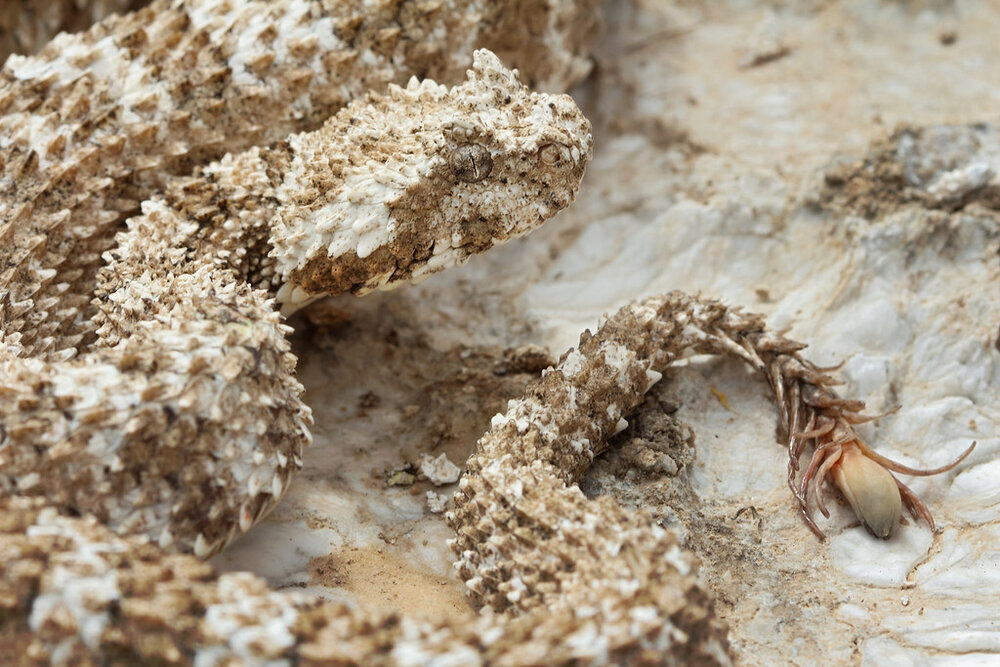Reptiles in Iran are unique in their kind

TEHRAN – Many wildlife species in Iran are unknown to ordinary people. It becomes clear when a video of a spider-tailed horned viper goes viral on social media, and many people wonder whether this strange animal really lives in Iran.
However, the world of reptiles is full of the unspoken, and many reptiles of the country are unique in their kind.
Hereunder is a brief description of the life and biological characteristics of some of the most unique snakes in Iran.
Montivipera latifii
The Montivipera species group consists of venomous snakes with 5 known species and sub-species; Montivipera albicornuta, M.latifii, M.raddei raddei, M.raddei kurdistanica, and M.kuhrangica, which their taxonomic situation is very controversial. These species live in alpine meadows from 1800 to more than 3200 meters from SL.
The populations of these species are really fragmented and are posed with the serious danger of extinction because of humane activities. Because of the high risk of extinction, M.latifii is sited in the Endangered category of the IUCN Red List. The first step to applying the conservation plans is to know the exact taxonomic situation and precise distribution areas.
Montivipera latifii is found in Iran in the upper Lar Valley in the Alborz Mountains. Unfortunately, the mountain plains that are home to this species are being severely degraded by overgrazing. Currently, the largest protected area of this species in Lar National Park has an uncertain future due to threats such as habitat destruction due to overgrazing and excessive tourist presence.
Eastern Montpellier snake
The eastern Montpellier snake (Malpolon insignitus) is a species of mildly venomous rear-fanged snake.
As you know, snakes often live individually and have no desire for group life; but this specie has a dominant male who selects a female in the breeding season, the male takes care of the female he has chosen; While the dominant male has several other males around him, those males are obedient to this dominant male.
Obedient males are those whose strength does not reach the dominant male but live near the dominant male. As a result, if the dominant male goes into conflict with another male, the obedient males help him. This is true even in the case of human conflicts.
Eirenis
Genus Eirenis, are often small in size. So far, 22 to 23 species of this genus have been identified in the world, and tens of species are distributed in Iran.
One of the interesting features of Eirenis snakes is that they are often half a meter or even smaller in size. Research shows that these snakes evolved from the large Dolichophis snake; That is, snakes that are often over one meter to one and a half meters in size have shrunk over evolution.
The emergence of Eirenis has greatly affected the biodiversity of these snakes because these snakes have greatly diversified.
The number of species of the genus Eirenis is much higher than that of the genus Dolichophis. At the same time, these snakes have found special adaptations.
Of course, the reduction in body size in the genus Eirenis has also brought some adaptations; For example, large Hierophis snakes, which are close to Eirenis snakes, often feed on warm-blooded prey, such as small rodents.
Spider-tailed horned viper
Being pushed toward extinction through poaching, the spider-tailed horned viper has been discovered in 2006. The venomous snake has a unique tail that has a bulb-like end bordered by long drooping scales that give it the appearance of a spider, which is waved around and used to lure insectivorous birds to within striking range.
There are no accurate statistics on the spider-tailed horned viper population, but it is spotted in the province of Ilam, Kermanshah, and Lorestan. To date, there have been no reports of spider-tailed horned viper being discovered in other countries.
The Convention on International Trade in Endangered Species of Wild Fauna and Flora (CITES) banned the illegal trade of spider-tailed horned vipers in August 2019.
The 18th meeting of the Conference of the Parties to the CITES CoP18 took place in Geneva, Switzerland, from 17-28 August 2019, through which Iran’s proposal to add rare spider-tailed horned viper to the Convention’s Appendix II has been accepted.
So, any trade of the species is permitted only with the CITES’s permission, and all 183 member parties are obliged to control the ports and prevent the trade of this viper.
Spider-tailed horned viper was declared endangered in November 2018.
Cerastes gasperettii
Cerastes gasperettii, commonly known as the Arabian horned viper, is a venomous viper species found especially in the Arabian Peninsula and north to Israel, Iraq, and Iran. It is very similar in appearance to C. cerastes, but the geographic ranges of these two species do not overlap. No subspecies of C. gasperettii are recognized.
First, this snake lives in very tropical areas of our country, such as Ahvaz (Al-Baji region) in the sandy and earthen hills, and has a limited distribution in Iran.
This snake is one of the species that have a high camouflage ability. It is completely colored similar to sand which helps camouflage it. On the other hand, the shape of the scales is also effective in hiding.
The scales are prominent and the two bands start from the side of the nose and extend along the face to the cheeks, appearing like two lines on the head from above. The spots on his body are not perfect zigzags, but they are spots
This snake is nocturnal and is not seen during the day due to the hot weather. Depending on its size, it chooses its prey and its diet consists of rodents and even lizards. One way to identify this snake is to leave a mark on the sandals.
Leave a Comment